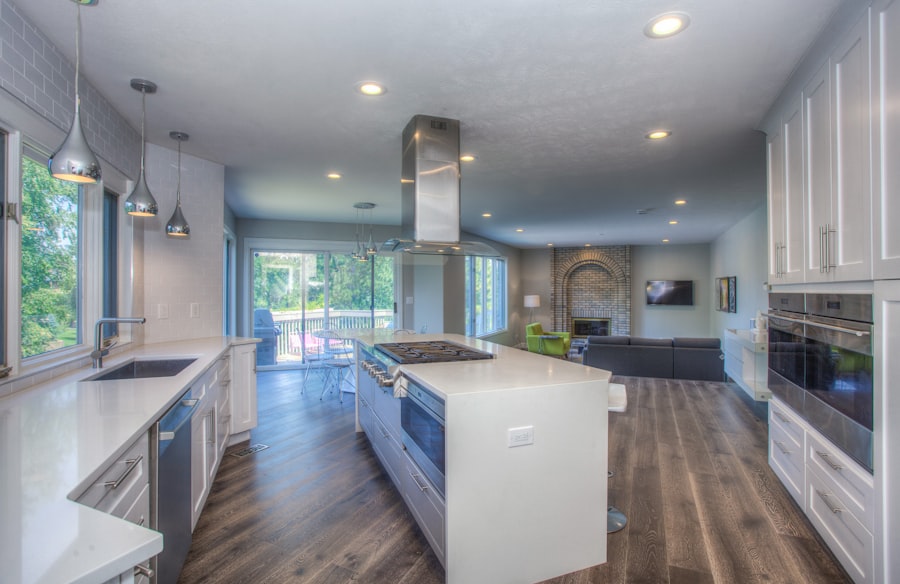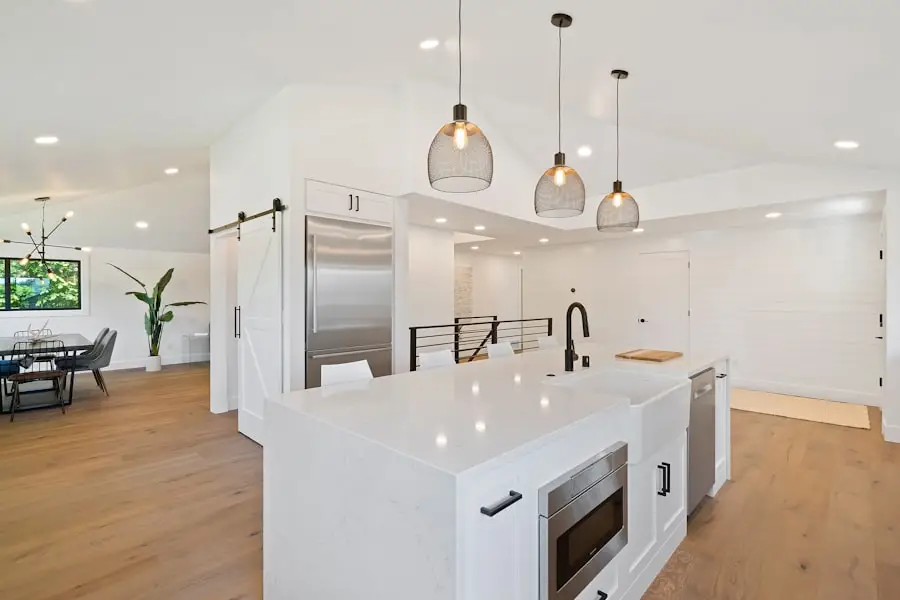As we navigate the ever-evolving landscape of real estate, it becomes increasingly important for us to stay informed about current market trends. The housing market is influenced by a myriad of factors, including economic conditions, interest rates, and consumer preferences. Recently, we have observed a shift towards more sustainable living, with buyers showing a preference for homes that incorporate eco-friendly features.
This trend not only reflects a growing awareness of environmental issues but also highlights the desire for long-term savings on utility bills. By understanding these trends, we can make informed decisions about renovations that will enhance the value of our properties. Moreover, the rise of remote work has transformed the way we view our living spaces.
With more people working from home, there is an increasing demand for dedicated office spaces and multifunctional areas within the home. This shift has prompted us to rethink how we utilize our existing spaces and consider renovations that cater to this new lifestyle. As we analyze these trends, we can identify opportunities to create environments that are not only aesthetically pleasing but also practical and conducive to modern living.
Key Takeaways
- Current market trends show a preference for energy-efficient and sustainable features in renovations.
- Key areas for renovation often include kitchens, bathrooms, and outdoor living spaces.
- Budgeting and planning for renovations should include a contingency fund for unexpected expenses.
- Choosing the right materials and finishes is crucial for achieving the desired aesthetic and durability.
- Hiring the right contractors and professionals is essential for a successful renovation project.
Identifying Key Areas for Renovation
When it comes to renovating our homes, identifying the key areas that require attention is crucial. We must assess both the interior and exterior of our properties to determine where improvements can be made. Common areas that often need renovation include kitchens and bathrooms, as these spaces tend to show wear and tear over time.
By focusing on these high-traffic areas, we can significantly enhance the overall appeal and functionality of our homes. In addition to kitchens and bathrooms, we should also consider the potential of underutilized spaces. For instance, basements and attics can be transformed into valuable living areas, such as guest suites or recreational rooms.
By recognizing the untapped potential within our homes, we can create additional space that meets our needs while also increasing property value. As we embark on this journey of renovation, it is essential to prioritize areas that will yield the greatest return on investment.
Budgeting and Planning for Renovations

Once we have identified the key areas for renovation, the next step is to establish a realistic budget and create a comprehensive plan. Budgeting is often one of the most challenging aspects of any renovation project, as costs can quickly escalate if not carefully managed. We should begin by obtaining quotes from contractors and suppliers to gain a clearer understanding of potential expenses.
This will allow us to allocate funds appropriately and avoid any unpleasant surprises down the line. In addition to budgeting for materials and labor, we must also consider contingency funds for unexpected costs that may arise during the renovation process. It is wise to set aside a percentage of our total budget—typically around 10-20%—to cover any unforeseen expenses.
By planning ahead and being financially prepared, we can ensure that our renovation projects proceed smoothly and stay within budget.
Choosing the Right Materials and Finishes
| Materials and Finishes | Benefits | Considerations |
|---|---|---|
| Wood | Natural, warm look | Prone to scratches and water damage |
| Steel | Durable and strong | Can rust if not properly treated |
| Glass | Sleek and modern | Requires frequent cleaning |
| Marble | Luxurious and elegant | Expensive and heavy |
Selecting the right materials and finishes is a critical aspect of any renovation project. The choices we make can significantly impact both the aesthetic appeal and durability of our renovations. We should consider factors such as style, maintenance requirements, and cost when making these decisions.
For instance, opting for high-quality materials may require a larger upfront investment but can lead to long-term savings due to reduced maintenance and replacement costs. Additionally, we should pay attention to current design trends when choosing finishes. Incorporating popular elements such as open shelving in kitchens or modern tile designs in bathrooms can enhance the overall look of our spaces while also appealing to potential buyers in the future.
By striking a balance between timeless design and contemporary trends, we can create spaces that are both functional and visually appealing.
Hiring the Right Contractors and Professionals
The success of our renovation projects largely depends on the professionals we choose to work with. Hiring the right contractors is essential for ensuring that our vision is executed effectively and efficiently. We should take the time to research potential contractors, checking their credentials, reviews, and past work to gauge their expertise.
It is also beneficial to seek recommendations from friends or family who have undergone similar renovations. Once we have narrowed down our options, conducting interviews with potential contractors can provide valuable insights into their communication styles and work ethics. Establishing a good rapport with our chosen professionals is crucial, as it fosters collaboration and ensures that our ideas are understood and implemented correctly.
By investing time in selecting the right team, we can set ourselves up for a successful renovation experience.
Incorporating Energy-Efficient and Sustainable Features

In today’s environmentally conscious society, incorporating energy-efficient and sustainable features into our renovations is not just a trend; it’s a responsibility. As we plan our projects, we should consider options such as energy-efficient appliances, solar panels, and high-quality insulation. These features not only reduce our carbon footprint but also lead to significant savings on energy bills over time.
Moreover, using sustainable materials—such as reclaimed wood or low-VOC paints—can enhance the eco-friendliness of our renovations while adding unique character to our spaces. By prioritizing sustainability in our renovation plans, we not only contribute positively to the environment but also appeal to a growing market of eco-conscious buyers who value green living.
Adding Curb Appeal and Outdoor Living Spaces
The exterior of our homes plays a vital role in first impressions, making curb appeal an essential consideration in any renovation project. Enhancing the exterior can involve simple updates such as fresh paint or landscaping improvements, which can dramatically transform the look of our properties. We should also consider features like new siding or updated windows that not only improve aesthetics but also increase energy efficiency.
In addition to curb appeal, creating outdoor living spaces has become increasingly popular among homeowners. Patios, decks, and outdoor kitchens provide valuable additional space for relaxation and entertainment. As we plan our renovations, incorporating these elements can significantly enhance our enjoyment of our homes while also increasing their market value.
By investing in both curb appeal and outdoor living spaces, we create inviting environments that reflect our lifestyle.
Maximizing Interior Space and Functionality
Finally, maximizing interior space and functionality is paramount in any renovation project. As we assess our homes, we should look for ways to optimize layouts and improve flow between rooms. Open-concept designs have gained popularity for their ability to create a sense of spaciousness while allowing for better interaction among family members.
Additionally, incorporating smart storage solutions can help us make the most of every square foot in our homes. Built-in shelving, under-stair storage, and multi-functional furniture are just a few examples of how we can enhance functionality without sacrificing style. By focusing on maximizing interior space, we create homes that are not only beautiful but also practical for everyday living.
In conclusion, embarking on a renovation journey requires careful consideration of various factors—from understanding market trends to maximizing space functionality. By taking a holistic approach that encompasses budgeting, material selection, contractor hiring, sustainability, curb appeal, and interior optimization, we can create spaces that truly reflect our needs and aspirations while adding significant value to our properties. As we move forward with our renovation plans, let us embrace creativity and innovation while remaining mindful of practicality and sustainability in every decision we make.
If you are considering home renovations to increase property value, you may want to check out this article on Emporia. This article provides valuable insights on how renovations can significantly boost the value of your property in Emporia. Whether you are looking to update your kitchen, bathroom, or outdoor space, this article offers helpful tips and advice to help you make informed decisions that will benefit you in the long run.

